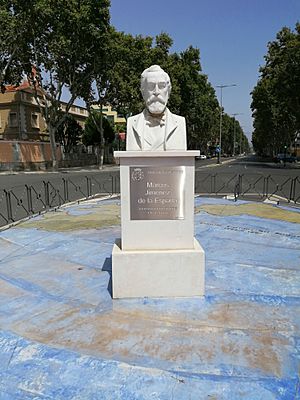Marcos Jiménez de la Espada facts for kids
Marcos Jiménez de la Espada (born in 1831, died in 1898) was a Spanish zoologist, explorer, and writer. He was born in Cartagena, Spain, but lived most of his life in Madrid. He is famous for being part of the Pacific Scientific Commission. With this group, he traveled across America from 1862 to 1865. He also wrote many books about the geography and history of the American continent.
Contents
Biography of Marcos Jiménez de la Espada
Marcos Jiménez de la Espada was the son of a politician. Because of his father's job, Marcos moved many times when he was young. He studied in cities like Valladolid, Barcelona, and Sevilla.
In 1850, he began studying Natural Sciences at the Universidad Complutense de Madrid. Five years later, he finished his studies. His final project was about amphibians, which are animals like frogs and salamanders. He loved studying and classifying amphibians, and this became a big part of his scientific work.
After getting his degree, he started working as an assistant. His first job was in the Natural history department at the university. In 1857, he also got a job at the Natural Science Museum of the Court. This museum is now called the Natural Science Museum of Madrid. For seven years, he focused on studying animals (zoology) and how their bodies are built (comparative anatomy).
Marcos Jiménez de la Espada's Scientific Work
Studying Animals: Zoology
During his travels in America, Marcos Jiménez de la Espada collected many different kinds of animals. He studied them carefully and even sent some live animals back to Madrid. Before the expedition, he had already worked for years preparing foreign animals at the Botanical Garden in Madrid. He learned a lot from his teacher, Mariano de la Paz Graells.
With this experience, it was easy for him to handle the many mammals, birds, and reptiles he found. Many of these animals had never been brought to Europe before. Some examples include the mara from Patagonia, the South American condor, and the guanaco. Many of the animals he brought back later had babies that were given to European zoos. Because of this, he won a special medal from a French zoological society in 1866.
After his American adventure, he spent six years just studying and organizing all the materials he had collected. He used these notes for his future books. In 1870, he wrote an article called Some new and curious facts about the Amazonian fauna. In this article, he described the appearance and behavior of the Thyroptera albiventer bat.
In 1871, he published another report called Unknown Species of Neo-tropical Fauna. That same year, he helped start the Spanish Society of Natural History. He published most of his later works through this society.
Marcos Jiménez de la Espada became a well-known author in Europe. His most important work in zoology was Vertebrados del viaje al Pacifico. Batracios. This book was published in 1875. He wrote it after studying 786 different species he collected during his trip. In the book, he described 18 types of animals that were already known. He also discovered and described 2 new groups (genera), 12 new species, and 3 new types (subspecies) of animals.
His book didn't just describe the animals' bodies. It also talked about their lives and how they behaved. He famously proved that the frog Rhinoderma darwinii didn't get pregnant in its mouth. Instead, he showed that it laid eggs, and then the male frog kept the eggs in its mouth until they hatched. This detailed study is still considered a very important work in zoology today.
Exploring Geography, History, and Culture
Even though he was very famous for his work with animals, Marcos Jiménez de la Espada decided to pause his zoology studies. He then focused on geography and the history of America. In 1876, he started the Geographic Society of Madrid. In 1883, he joined the History Academy.
From there, he helped re-publish important old books. These included works by famous travelers like Pero Tafur and the Jesuit priest Bernabé Cobo. He also re-published books about ancient Perú by Pedro Cieza de León and Bartolomé de las Casas. From 1881 to 1897, he published four volumes of his own work called Geographic Relations of the Indies. This work won him a special award called the Loubat prize. In 1882, he became a member of the American Antiquarian Society.
He also attended many meetings and conferences in cities like Brussels, Madrid, Turín, Berlin, and Paris. He worked hard to share information about the Inca culture. Because of this, the government of Perú gave him a Gold Medal. He also became a member of many international groups. In 1895, he was chosen to be the president of the Spanish Society of Natural History, the group he helped create.
Interestingly, he didn't get his final university degree (his doctoral thesis) until April 1898. This was just three months before he was named a professor of comparative anatomy. He died six months later. His death stopped him from finishing a big study he was working on. This study was about a sea expedition by Alessandro Malaspina in the 1700s. After he died, his friends, like Francisco Giner de los Ríos, honored him. They said he was a symbol of new scientific ideas in Spain.
See also
 In Spanish: Marcos Jiménez de la Espada para niños
In Spanish: Marcos Jiménez de la Espada para niños




